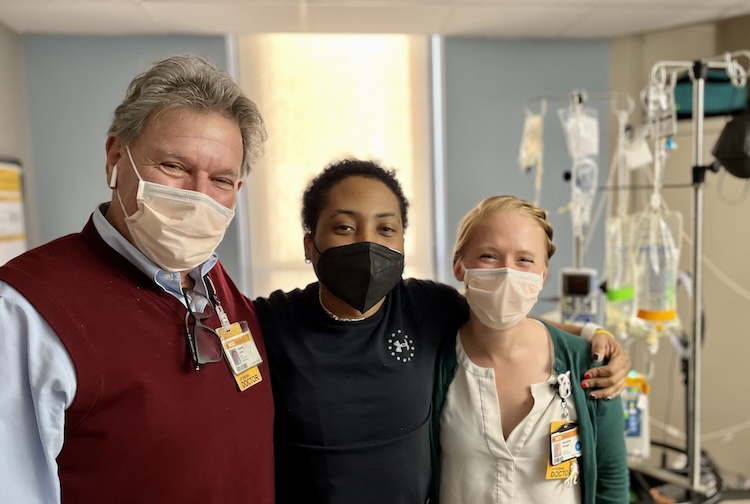
FDA-approved treatments use gene therapy to help patients with sickle cell disease
A VCU School of Pharmacy expert breaks down how gene therapies work to relieve pain for sickle cell patients and discusses other potential treatments on the horizon.
December 18, 2023 Sickle cell disease affects about 100,000 people in the United States and millions more across the world. The genetic disorder causes red blood cells to form into rigid “sickle” shapes, resulting in severe pain and organ damage, among other health issues. (Getty Images)
Sickle cell disease affects about 100,000 people in the United States and millions more across the world. The genetic disorder causes red blood cells to form into rigid “sickle” shapes, resulting in severe pain and organ damage, among other health issues. (Getty Images)
By Olivia Trani
The U.S. Food and Drug Administration recently approved two gene therapies, Casgevy and Lyfgenia, to treat sickle cell disease in people ages 12 and older. One of the therapies, Casgevy, use a novel gene-editing technique called CRISPR/Cas9, which can modify a cell’s DNA at a targeted location to turn certain genes on or off. The decision marks the first time that a gene-editing treatment has been approved for any human illness.
Sickle cell disease is an inherited blood disorder affecting about 100,000 people in the United States. Individuals with this genetic illness experience debilitating levels of pain and irreversible damage to their organs. The disease disproportionately affects African Americans, and medical research on treatments historically was neglected and underfunded due to biases toward race and ethnicity.
“Despite the fact that sickle cell disease was the first to be understood at the molecular level, patients had limited treatment options for several decades,” says Martin Safo, Ph.D., a professor in the Department of Medicinal Chemistry at Virginia Commonwealth University's School of Pharmacy who has been working on drug discovery for sickle cell disease for almost 30 years.
The FDA approved the two gene therapies after clinical trials demonstrated that 93.5% and 88% of participants reported no pain for one year following treatment. One of those participants is VCU Health patient named Walter Davis. He received care from India Sisler, M.D., and Elizabeth Krieger, M.D, at Children’s Hospital of Richmond at VCU's pediatric comprehensive sickle cell center, as well as Wally R. Smith, M.D., and Thokozeni Lipato, M.D., from the adult sickle cell program at VCU Health while participating in the clinical trial.
Safo spoke with VCU Health News about the new treatments as well as other therapies in development to help give patients a new life.
What causes sickle cell disease, and how does the disorder impact a person’s daily life?
Sickle cell disease occurs through a genetic mutation that creates an altered form of hemoglobin, the protein that helps red blood cells deliver oxygen throughout the body. The defect causes hemoglobin to form into clusters which causes the red blood cells to become distorted into “sickle” shapes.
Normally, red blood cells are disc-shaped and flexible enough to flow easily through blood vessels. However, sickle-shaped red blood cells are rigid, making them more susceptible to damage as they circulate through the bloodstream, sometimes even becoming lodged or stuck in small blood vessels. This causes people to experience inflammation and excruciating periods of pain, called pain crises, on a nearly daily basis. Patients with sickle cell disease also have an increased risk for other health problems, such as severe anemia, stroke, infections and progressive organ damage. The symptoms can cause individuals to spend days or weeks in the hospital and have reduced life expectancy.
What has been the standard treatment for sickle cell disease?
In the past 30 years, there have been four FDA-approved drugs to treat sickle cell disease.
- Hydroxyurea induces fetal hemoglobin production to help prevent red blood cells from becoming sickle-shaped.
- L-glutamine (Endari) reduces oxidative stress, which can help red blood cells regain their flexibility as they travel through blood vessels.
- Crizanlizumab (Adakveo) prevents blood cells from sticking to the inner lining of blood vessels.
- Voxelotor (Oxbryta) increases hemoglobin’s affinity for oxygen to stop the proteins from aggregating, consequently preventing red blood cells from becoming misshapen.
However, these approaches have only had a modest impact on treating symptoms and patients still experience harsh conditions as a result of this disease. Additionally, patients may receive blood transfusions to replace defective sickle hemoglobin, penicillin and pneumonia vaccines to reduce the risk of infections, as well as opioids to alleviate sickle cell pain crises.
More advanced measures can be taken to reduce or even eliminate the effects of sickle cell disease. For example, stem cell transplantation can be a cure for patients with the most severe forms of the disease. However, to go through with the procedure, a sibling of the patient needs to match as the stem cell donor, and patients can suffer from critical side effects, such as transplant rejection and even death.
How is CRISPR/Cas9 technology being used to treat sickle cell disease?
Gene therapy with CRISPR/Cas9 involves cutting a piece of DNA in bone marrow stem cells from the patient. The altered stem cells are infused back into the patient, which then begins to produce another form of hemoglobin, fetal hemoglobin, that does not clump together or make red blood cells sickle.
This form of gene-correction treatment may be suitable for patients with very severe cases of sickle cell disease, but it still requires a stem cell transplant to ensure the gene-modified cells can attach and multiply in the bone marrow and take the place of a significant portion of the bone marrow cells.
What are some of the barriers to access that still need to be addressed for gene therapy?
There are concerns about the price of the therapy, which is expected to cost upwards of $3 million per patient, which is beyond what many families can afford out-of-pocket. The treatment is also a very complex process, requiring frequent and extended stays in the hospital.
You and your colleagues at the VCU School of Pharmacy have been involved in developing a treatment option for sickle cell disease, called ILX-002. Can you explain how this medication could be used to treat this illness? And what is the status of this research project?
For the past three decades, our group at the VCU School of Pharmacy, and collaborators from the Children Hospital of Philadelphia, King Abdulaziz University in Saudi Arabia, and Illexcor Therapeutics, has been involved in the development of therapeutic agents to treat sickle cell disease. The over-arching goal is to develop a pill that can be taken once per day that allows individuals to have long-lasting lives that are largely free from the adverse effects of the disease.
Our focus has been finding a way to prevent sickle hemoglobin from forming clusters, which in turn could mitigate the downstream effects of the disease. Our latest drug candidate ILX-002 can directly bind to sickle hemoglobin and interfere with the aggregation process, and it is the first such drug to have this effect.
This type of treatment is the holy grail for sickle cell disease because there are simply too many people throughout the world with this condition to treat with gene-editing. Furthermore, if we can modify the disease significantly with a safe and effective pill, then more involved procedures would hopefully only be needed by individuals with the most severe cases of the disease. We anticipate that ILX-002 will begin human clinical trials in early 2025.



